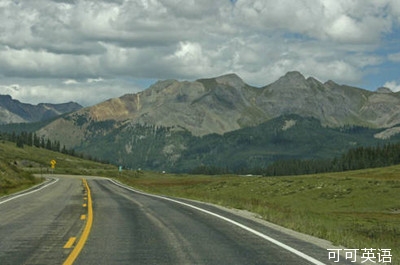(单词翻译:单击)
Anyone who has vacationed in the higher elevations of Colorado, such as Vail and Estes Park, will tell you altitude sickness can be a real problem.
任何在科罗拉多的高海拔地区如韦尔和洛杉矶国家公园等旅游胜地度过假的人都会告诉你,高原反应真的是要命的问题。
Loss of appetite, nausea, vomiting, weakness, dizziness, and difficulty sleeping can plague those visiting areas over eight thousand feet.
食欲不振,恶心,呕吐,身体虚弱,头晕,入睡困难等症状可能折磨那些在海拔超过8000英尺区域旅游的人们。
Altitude sickness results from the lack of oxygen at high elevations.
由于海拔较高而缺氧造成高原反应。
At thirteen thousand feet, every lungful of air holds only sixty percent of what it would at sea level.
在13000英尺高的地方,肺仅能容纳海平面高度时60%的空气。

Despite that fact, many indigenous people live in areas of low oxygen concentration with few adverse effects.
尽管如此,许多在低氧地区的原居民很少有不良反应。
The big question is, how do they survive?
那么值得我们思考的是,他们是怎样存活的呢?
The body can adapt to low oxygen levels by making more hemoglobin, an oxygen-carrying molecule in red blood cells.
在氧气稀薄的情况下,身体能够产生一种适应环境的血红蛋白,这种血红蛋白即是红细胞的氧气载体。
But too much hemoglobin over a long period of time can put a person at risk of blood clots, stroke, or chronic mountain sickness.
但是太多的血红蛋白长时间存在可能导致人体产生血液凝块,患上中风或者患慢性高原病。
Scientists wondered how mountain people can remain healthy living at high altitudes.
科学家想知道在高原生活的人们怎样维持健康。
To see if genes contribute, scientists analyzed the genomes of three ethnic groups living at altitudes over twelve thousand feet, two from Ethiopia, and Tibetans.
科学家们为了证实基因是否有关,他们对3组生活在超过12000 英尺区域种族群体做了染色体分析,其中有两组人来自埃塞俄比亚,另外一组来自西藏。
One Ethiopian group, the Oromo, cope the same way lowlanders do, by making more hemoglobin.
其中一组的埃塞俄比亚奥罗莫人与其他地方人一样,他们的身体产生更多的血红蛋白抵抗低氧环境。
The Amhara and Tibetans, on the other hand, have hemoglobin levels ten percent lower than the Oromo.
阿姆哈拉人和西藏人的血红蛋白含量比奥罗莫人低10%左右。
Does genetic variation account for this?
是基因变异导致这种情况吗?
Scientists found that both the Amhara and Tibetan highlanders possessed genetic variants associated with low hemoglobin levels.
科学家发现阿姆哈拉人和西藏人都有基因变异以维持低血红蛋白水平。
But they were not the same genes.
但是他们的基因却不同。
It appears that each group took a different evolutionary path to achieve the same outcome of dampening the usual response of increased hemoglobin.
看起来他们走了不同的进化历程,却达到了相同的结果,那就是抑制人体在患高空症时血红蛋白的增长。
How about all those vacationers in Colorado?
在科罗拉多度假的人们怎么办呢?
They will have to make do with their own lowland genes, for now.
目前只能用他们的低地基因来勉强应付了。


